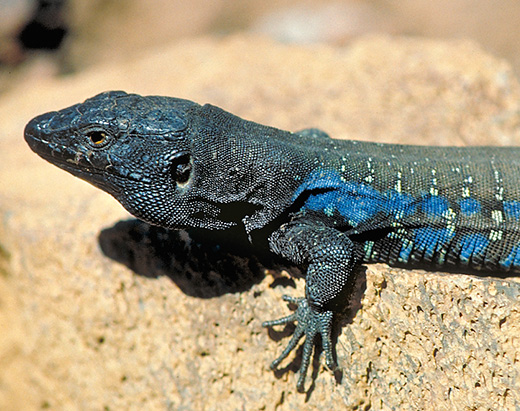What is Mount Teide?
Mount Teide, a World Heritage Site
With its three-million-year-old lava flows, volcanic cones, strata, and ancient rocks, this may look like a scene from another world, but in fact Mount Teide is located in the centre of Tenerife, its lava-strewn landscape stretching across the vast caldera of Las Cañadas. This is the Teide National Park, home to the highest peak in Spain and the third largest volcano on the planet. An overwhelming, spellbinding sight that takes the breath away with its colours and twisted forms. Never has such a bleak landscape ascended to this level of beauty.

This 3,718-metre volcano is surrounded by desert—austere but with a wild beauty that never fails to impress. This extraordinary landscape of volcanoes and unusual volcanic formations, with its astonishing contrasts and amazing natural phenomena, such as the sea of clouds, led Unesco to declare it a World Heritage Site in 2007. We need to add another compelling reason that confirms Mount Teide’s unique place in the world: it is, without a doubt, the best place to identify the Earth’s evolutionary stages. One only has to observe the changes in colour and appearance of this extraordinary stratovolcano, born not on the edges of one of the Earth’s tectonic plates, but deep inside it.
How was the volcano, and the highest peak in Spain, formed?

Teide is not merely the most visited national park in Spain and Europe. It is one of the most spectacular manifestations of volcanic activity on Earth, formed 120,000 years ago after a landslide caused by the eruption of the ancient Las Cañadas volcano.

Eruption followed eruption, and the successive layers of lava built up until they reached a height of 3,718 metres—which is why it is known as a stratovolcano. Together with the second-highest peak on Tenerife, Pico Viejo, Mount Teide forms the Teide-Pico Viejo stratovolcano. This is a very young volcano if you take into account that the caldera of Las Cañadas, from which it rises, is over three-and-a-half million years old.

This astounding natural amphitheatre measuring 15 kilometres in diameter—one of the largest calderas in the world—continued filling with material produced by various volcanic eruptions through the years, creating a landscape as indomitable as it is spectacular. Its sights include: Montaña Blanca, the Roques de García (one of the most popular spots with visitors), Montaña Rajada, Montaña Mostaza and El Llano de Ucanca (the Plain of Ucanca), which enjoys some of the best views of Mount Teide.

The wonderful, varied colouring is due to the materials and minerals in the rock: the whitish and yellow tints of the pumice stone, the reddish and black tones generated by the natural oxidisation (from which the basalt stones of the lava fields are formed), and the black gleam of the obsidian. An extraordinary richness of geological shapes, forms and colours which attracts over three million visitors annually.
The 10 most iconic species of Las Cañadas del Teide
Mount Teide’s palette of colours would not be the same without its rich, varied vegetation, consisting of over 60 native species. Life at an altitude of 2,000 metres is possible, and the proof that the Teide National Park is the best example of a high-altitude volcanic ecosystem in the Canary Islands lies in the fact that its lava flows are home to animal species, mainly invertebrates—although there are some highly unusual vertebrates too.
Make time to stop and discover how life still manages to prosper even in this inhospitable setting, and find the 10 most iconic of its many species of flora and fauna:
Five things you never knew about Mount Teide
Although almost everything is known about this volcano (which the Canary Islands’ original inhabitants knew as Echeyde, and considered to be a sacred mountain), Mount Teide still preserves a few secrets and oddities that you should know about:
Within the Park, there are over 1,000 archaeological sites dating from the time of the “Guanches”, the original population.
The base of Mount Teide was formed in 40,000 years, a very short period of time archaeologically speaking.
The land here is among the most fertile on the planet, as the volcanic ash imparts an astonishing wealth of nutrients to the soil.
No human casualties have even been recorded as a result of Mount Teide’s volcanic eruptions.
Its volcanic landforms are very unusual in comparison with those of other volcanoes.
WHERE IS MOUNT TEIDE?
Teide National Park is located in the centre of Tenerife, at an average altitude of 2,000 metres. It receives, on average, 3.5 million visitors per year. It is, therefore, the most visited national park in Spain and Europe. In it, is Spain’s highest summit—the Teide peak—which is 3,718 metres high.
Due to its volcanic and biological uniqueness, it was declared National Park in 1954, and it was given World Heritage Site status in 2007. In 2014, it became the first World Heritage Site to be designated as a ‘Starlight Destination’ owing to the quality of its sky for astronomical observation. Here, you can find the Teide Cable Car facilities, the Altavista Refuge and the Teide Observatory, which is the largest solar observatory in the world.









